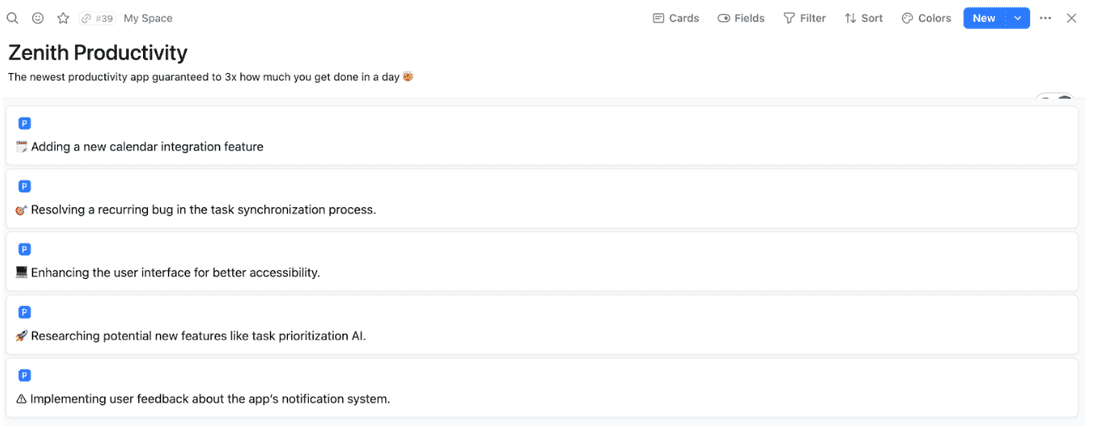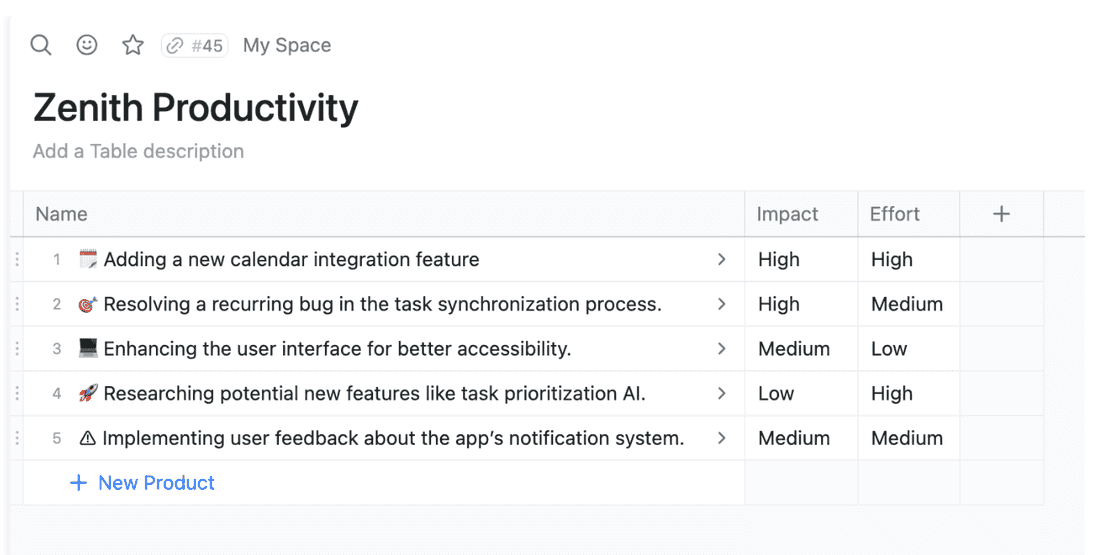What Is an Action Priority Matrix (With Template)
The Action Priority Matrix: sounds like something out of a high-stakes action movie, doesn’t it?
Picture this: a group of seasoned product managers, armed with coffee cups and laptops, gathered around a table, racing against the clock to plot their next big move before the villain takes over their city.
Okay, maybe it’s not quite that dramatic. But let’s face it, in the world of product management, sometimes it feels just as intense.
And in this world, you need all the tools you can get to handle the intensity. One of the best tools is the Action Priority Matrix.
In this article, we’re going to unravel all of the mysteries of the Action Priority Matrix.
You’ll learn what it is, why it’s crucial in the realm of product management, and how to use it effectively. We’ll also provide you with a handy template, because who doesn’t love a good shortcut to efficiency?
Let’s dive in and transform the way you prioritize, one task at a time.
What is an Action Priority Matrix?
The action priority matrix doesn’t take place in a high-speed Hollywood movie, instead, it takes place in the high-speed world of product management.
The Action Priority Matrix is a straightforward and effective tool for sorting tasks. It is a very efficient method to help you determine which tasks are important and need immediate attention and which ones are less crucial and can wait.
The matrix operates on two axes: one axis represents the effort or resources required to complete a task (low to high), and the other axis signifies the impact or value that completing the task will bring to your product (also low to high). Where each task falls on these axes determines its priority level.
This method categorizes tasks into four distinct quadrants:
- Quick Wins: Low effort, high impact tasks. These are the tasks you should tackle first as they provide significant value with relatively little effort.
- Major Projects: High effort, high-impact tasks. These are important but will require more resources and time.
- Fill-Ins: Low-effort, low-impact tasks. These are not urgent but can be completed as and when you have spare time.
- Thankless Tasks: High-effort, low-impact tasks. Ideally, these should be avoided or re-evaluated, as they consume a lot of resources for little reward.
Understanding and utilizing the Action Priority Matrix enables product managers to make strategic decisions about where to focus their efforts. Using a prioritization matrix ensures that you are not just busy, but productive, focusing on tasks that propel your product forward in meaningful ways.
The Use of the Action Priority Matrix in Product Management
In the realm of product management, the Action Priority Matrix is not just a theoretical concept; it’s a practical tool that brings clarity and direction to your daily workflow.
Let’s delve into how you can apply this matrix using Fibery, turning it into an actionable template for your product management needs.
Step-by-Step Application in Product Management
1. Identify and List Tasks

Start by listing all the tasks on your plate.
These could range from developing new features, addressing technical debt, and handling customer feedback, to improving user experience. No task is too small – if it’s on your radar, it goes on the list.
2. Assess Each Task

For each task, evaluate the level of effort required and the potential impact it could have on your product.
This assessment doesn’t have to be an exact science; approximate evaluations based on your experience and knowledge of the product are sufficient.
3. Plot Tasks on the Matrix

Using Fibery, create a matrix with two axes – Effort (Low to High) and Impact (Low to High).
Now, plot each task on this matrix based on your assessment.
This visual representation will immediately show you which tasks are Quick Wins, Major Projects, Fill-Ins, or Thankless Tasks.
4. Prioritize Accordingly
Focus your immediate efforts on the Quick Wins – these tasks will give you the most significant return with the least amount of resource expenditure.
Next, schedule your Major Projects; these are critical for long-term success but require more resources.
Fill-Ins can be tackled in downtime, while Thankless Tasks should be re-evaluated to see if they’re necessary at all.
Using Fibery as Your Template
With Fibery, creating an Action Priority Matrix becomes an intuitive process. You can visualize your tasks in a customizable format, making it easy to categorize and prioritize them effectively.
The ability to update and modify this matrix in real time allows for a dynamic approach to task management, reflecting changes and new priorities as they arise.
The Pros and Cons of the Action Priority Matrix in Product Management
While the Action Priority Matrix is a valuable tool in the arsenal of a product manager, like any tool, it has its strengths and limitations. Understanding these can help you leverage the matrix more effectively in your product management strategy.
Pros of the Action Priority Matrix
1. Clarity in Prioritization
The matrix’s greatest strength lies in its ability to provide clear visual guidance on task prioritization.
By categorizing tasks into quadrants, it helps product managers quickly identify which tasks will have the greatest impact with the least effort (Quick Wins) and which ones are resource sinks with low returns (Thankless Tasks).
This clarity is invaluable in a field where decision-making can often become overwhelming.
2. Enhanced Team Alignment
When used as a collaborative tool, the Action Priority Matrix can foster better alignment and understanding within the team.
It makes prioritization a transparent process, allowing team members to see the rationale behind why certain tasks are prioritized over others.
This can enhance team cohesion and reduce conflicts arising from misaligned expectations.
Cons of the Action Priority Matrix
1. Oversimplification of Tasks
One potential downside is the matrix’s tendency to oversimplify complex tasks. Product management often deals with tasks that have multiple dimensions and implications, which may not be adequately captured in a two-dimensional matrix.
This can lead to a skewed understanding of a task’s true effort and impact.
2. Subjectivity in Assessment
The effectiveness of the Action Priority Matrix largely depends on the accuracy of the effort and impact assessment.
These assessments can be subjective and vary significantly based on individual perspectives.
Inaccurate evaluations can lead to misprioritization, with critical tasks being overlooked or less important tasks receiving too much focus.
Balancing the Matrix in Product Management
For product managers, the key is to use the Action Priority Matrix as a guide, not a rigid rule. It should be complemented with other tools and insights, such as market analysis, user feedback, and team input.
Integrating the matrix into a broader strategic framework allows for a more nuanced approach to prioritization, ensuring that decisions are both data-driven and contextually informed.
The PM’s Hot Take
After a few years as a PM, you see your fair share of tools and techniques come and go, but the Action Priority Matrix holds a special place. It’s like a compass in the wild seas – simple, yet profoundly impactful. Buyers beware, though: don’t fall into the trap of treating it as gospel. It’s a starting point, not the finish line. The real skill lies in interpreting its insights within the context of our dynamic product landscape. The matrix points us in the right direction, but it’s our understanding of the product, market, and user needs that ultimately drives our journey. In short, use the matrix to cut through the clutter, but trust your instincts and experience to navigate the nuances of real-world product management.
Conclusion
Embracing the Action Priority Matrix in product management is about striking the perfect balance between structured strategy and adaptive intuition.
It’s a tool that offers clarity, but the real magic happens when it’s coupled with your expertise and understanding of the product landscape. Use it as a compass to navigate through the complexities of your tasks, but always keep your finger on the pulse of the market and user needs.
If you’re eager to dive deeper into effective product management strategies, be sure to explore more insights and resources at Fibery.
Here, you’ll find a wealth of information and tools designed to enhance your product management journey, helping you turn challenges into opportunities for growth and success.
And if you are looking for other templates, the content marketing, usability testing, fundraising, or the integromat template are all there (or just check out our template library).
Psst... Wanna try Fibery? 👀
Infinitely flexible product discovery & development platform.